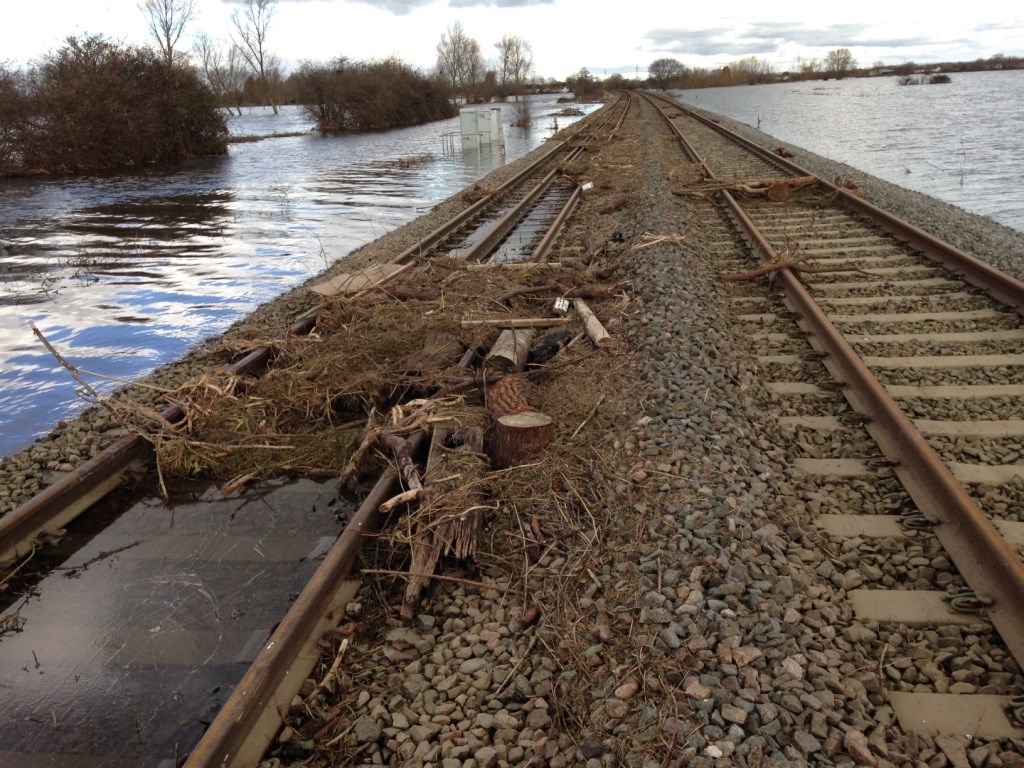Wednesday 5 Mar 2014
Rail plans mobilised to restore services through Bridgwater
- Region & Route:
- | Wales & Western: Western
- | Wales & Western
Network Rail is mobilising its engineers to assess damage to the railway, whilst exploring a temporary solution to enable some services to run, as flood water starts to recede at Bridgwater.
The majority of the 2000 yards of track, embankment and signalling equipment at Bridgwater have emerged from the water and this has enabled engineers to access the infrastructure and remove all the debris from the track. However, to determine the extent of damage and scope of repair required, a thorough technical assessment will be essential before repairs are made.
Patrick Hallgate, route managing director, Network Rail Western said: “We are determined to do everything we can to get passengers on the move again. We got into action as soon as the water receded sufficiently but careful examinations by our engineers remain vital as the infrastructure has been submerged for a long time. Whilst assessing the damage, we will also be reviewing a temporary signalling solution that could enable some trains to operate, which will significantly reduce disruption to passengers.”
The railway between Taunton and Bridgwater currently remains closed until further notice. Passengers travelling through Bridgwater are advised to check with the National Rail Enquiries or their train operating companies for information on alternative services. - end -
Notes to editors
Tracks: are full of debris - mostly plant matter like large logs and branches, some lodged in points or other moving parts, stopping them working. This has to be cleared by hand. Mud has to be removed from the rails, which will affect traction. Currents flowing across the line of the rail may have moved it out of alignment (horizontally and/or vertically) which may not be visible to the naked eye.
Ballast: for safety and reliability, ballast may need removing, cleaning and replacing. Granite ballast that is covered in muck and grime will not tessellate (the sharp edges will not grip and hold as a heavy train goes over), but will slide around which affects the track.
There are special trains that dig out ballast, weigh it, clean it, replace it and add more if needed but they are unable to go on the embankments if they are unsafe
Embankments may have been undermined by waves eroding their sides. Flowing water may have washed away soil or ballast under the track. Saturated soil has less structural strength than normal soil.
As the flood waters recede, checks will be carried out on the embankments to examine if they are strong enough to carry the weight of a passing train, and assess the risk of landslips.
Signalling: miles of cables have been immersed for a long time, plus electrical cabinets and signals flooded out. This is a critically important element of safe rail travel.
Contact information
Passengers / community members
Network Rail national helpline
03457 11 41 41
Latest travel advice
Please visit National Rail Enquiries
Journalists
Network Rail press office -Western route
MediaRelationsWestern@networkrail.co.uk
About Network Rail
We own, operate and develop Britain's railway infrastructure; that's 20,000 miles of track, 30,000 bridges, tunnels and viaducts and the thousands of signals, level crossings and stations. We run 20 of the UK's largest stations while all the others, over 2,500, are run by the country's train operating companies.
Usually, there are almost five million journeys made in the UK and over 600 freight trains run on the network. People depend on Britain's railway for their daily commute, to visit friends and loved ones and to get them home safe every day. Our role is to deliver a safe and reliable railway, so we carefully manage and deliver thousands of projects every year that form part of the multi-billion pound Railway Upgrade Plan, to grow and expand the nation's railway network to respond to the tremendous growth and demand the railway has experienced - a doubling of passenger journeys over the past 20 years.
Follow us on Twitter: @networkrail
Visit our online newsroom: www.networkrailmediacentre.co.uk

